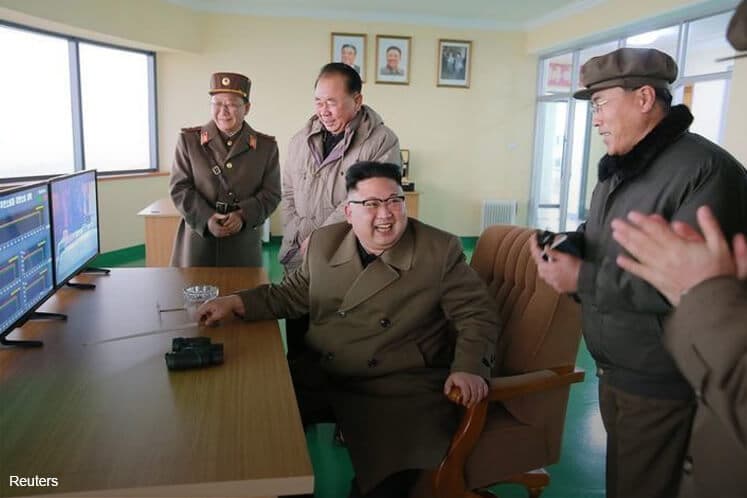
AS US Secretary of State Rex Tillerson warned Washington’s “strategic patience” with North Korea has ended and “all options are on the table” to slow its nuclear ambitions, US and South Korean forces were preparing for a range of military scenarios.
As many as 300,000 mainly South Korean and US personnel are involved in military drills that will run until the end of April. These exercises have been a feature of life on the peninsula since the Korean War ended in a 1953. In recent years, they have become larger and more realistic.
Every US president since at least Bill Clinton has confronted North Korea’s weapons programme and been offered a range of potential military action to tackle them. So far, none has been willing to strike — primarily because all the options are bad, particularly given the risk of North Korean retaliation that could turn the peninsula, and perhaps the wider region, into a bloodbath. At worst, violence on the peninsula could even drag the US into war with China, just as it did in the original Korean War.
As Pyongyang moves forward with warhead and missile testing, however, many experts believe the likelihood of Washington finally taking such steps is gradually increasing.
US President Donald Trump said will he will not allow Pyongyang to develop the ability to strike the US with nuclear force. If he orders a limited strike on its facilities, however, North Korea’s nuclear progress may only slow temporarily — and such an operation could spark brutal North Korean retaliation. A broader effort to bring down the entire regime would be an enormous undertaking. Small wonder, then, that the US has preferred to stick with alternative techniques such as economic sanctions and cyberattacks to interfere with missile tests. The recent deployment of the Terminal High Altitude Area Defense antiballistic missile batteries in South Korea and Japan should offer some protection, although no one knows how effective they would be against North Korean missiles.
If Washington did choose to go further, the most likely action would be sudden, hopefully overwhelming bombing raids on suspected North Korean missile and weapons facilities. While such action would be unlikely to destroy the programme out right, it would slow development. At best, it would prevent Pyongyang from perfecting some of its more ambitious weapons programmes, such as mounting ballistic missiles in diesel electric submarines.
The largest acknowledged conventional bomb in the US Air Force arsenal — the 30,000 -pound (13,600kg) GBU-57 Massive Ordinance Penetrator – was designed with just this sort of target in mind. Built by the George W Bush administration primarily to destroy Iranian nuclear facilities, it could be dropped from B2 stealth bombers flying from either regional bases or the continental US. Unlike more conventional jets, the B2s should be able to penetrate North Korean airspace largely undetected, perhaps joined by some of the more modern F-22 Raptors and perhaps even the newly operational F-35 Joint Strike Fighters now deployed in the region.
The reason such strikes have not been launched so far is the same reason they were never launched against Iran’s nuclear programme. Many experts believe they would leave many facilities intact — and the potential retaliation might be devastating. With North Korea, the worry is that Pyongyang might launch missile strikes against Japan and regional US bases such as Guam and a devastating artillery barrage into South Korea.
Analysts disagree over just how effective that barrage would be — some suggest North Korean artillery could land up to 500,000 shells in the South Korean capital within the first hour; others are more sceptical. There is also the fear that if the North believed its rockets and warheads were under threat, it might fire them — with Japan the most likely target.
Either action would probably spell the end for the North Korean regime, prompting Washington and Seoul to put into action already existing plans to overrun the North. Over the last few years, US and South Korean forces have shifted their focus from training to stop a North Korean offensive to having plans in place for a comprehensive invasion across the Demilitarized Zone. That would be a major undertaking, one that would dwarf any war the US — or any other country — has fought in recent history. Attacking troops would face mountainous terrain, concerted opposition and potential chemical, nuclear and radiological threats.
There are some signs the US might try to halt escalation by simply decapitating the regime. According to South Korean news agency Yonhap, this month’s exercises included US Navy SEAL Team Six, the unit that conducted the 2011 raid that killed Osama bin Laden. They were working with South Korean counterparts to simulate a strike on the North Korean leadership, according to a South Korean military official quoted by the news agency. Such an option would be extremely hard to put into practice.
North Korea’s air defences make sending troops by helicopter difficult, while North Korean leader Kim Jong-un is believed to be heavily guarded. For now, Kim appears to think he can keep ramping up his nuclear programme unchallenged. Washington, though, may not be willing to watch from the sidelines.
Trump is one of the most unpredictable presidents to ever hold that office. If any US leader is going to take a risk with military options in North Korea, he very well might be the one.
It’s an unenviable choice. Action could provoke disaster. But failure to do anything might be blamed for a future conflict that could be even worse. — Reuters